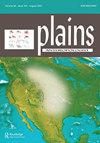Microblade technology, obsidian sourcing, and the Cody complex in early Holocene Alberta
Q2 Social Sciences
引用次数: 7
Abstract
Despite being an ephemeral presence in Plains archaeological assemblages, the distribution and technical specificity of early Holocene (Denali complex) microblade technology makes it readily identifiable and comparable to similarly-aged Paleoindian projectile point occurrences. In this paper we review the co-occurrence of Denali and Cody complex materials in Alberta, in particular the obsidian and Knife River Flint (KRF) artifacts of these two early Holocene archaeological complexes, employing both lab-based (EDXRF) and portable X-ray fluorescence (pXRF) analyses. A strong pattern is revealed of southern (Wyoming, Idaho, North Dakota) obsidian sources being limited to southern Alberta microblade and Cody artifacts while northern obsidian sources in British Columbia are only attributed to artifact assemblages from northwestern Alberta and northern British Columbia. Northeastern British Columbia and most of Alberta were ice free at 11,000–10,000 cal BP, and Denali-related artifacts across the deglaciated corridor area indicate southward movement of this technology at a time when the region was also being more broadly and intensively utilized by people using Cody complex technology. We offer scenarios to explain Denali and Cody complexes’ archaeological co-occurrence, while recognizing technical issues in pXRF source identification.阿尔伯塔全新世早期的微刃技术、黑曜石来源和科迪复合体
尽管在平原考古组合中是短暂的存在,但全新世早期(德纳里复合体)微刃技术的分布和技术特殊性使其易于识别,并可与相似年龄的古印第安弹射点事件进行比较。本文采用实验室(EDXRF)和便携式x射线荧光(pXRF)分析,回顾了阿尔伯塔省Denali和Cody复合体材料的共存,特别是这两个全新世早期考古复合体的黑曜石和Knife River Flint (KRF)人工制品。南部(怀俄明州,爱达荷州,北达科他州)的黑曜石来源仅限于阿尔伯塔省南部的微刃和科迪文物,而不列颠哥伦比亚省的北部黑曜石来源仅归因于阿尔伯塔省西北部和不列颠哥伦比亚省北部的人工制品组合。不列颠哥伦比亚省东北部和阿尔伯塔省的大部分地区在11000 - 10000 cal BP时是无冰的,在冰川消退的走廊地区,与德纳里有关的文物表明,在该地区使用科迪复杂技术的人们更广泛、更密集地利用科迪复杂技术的时候,这项技术向南移动。我们提供了场景来解释Denali和Cody复合体的考古共存,同时认识到pXRF源识别中的技术问题。
本文章由计算机程序翻译,如有差异,请以英文原文为准。
求助全文
约1分钟内获得全文
求助全文

 求助内容:
求助内容: 应助结果提醒方式:
应助结果提醒方式:


